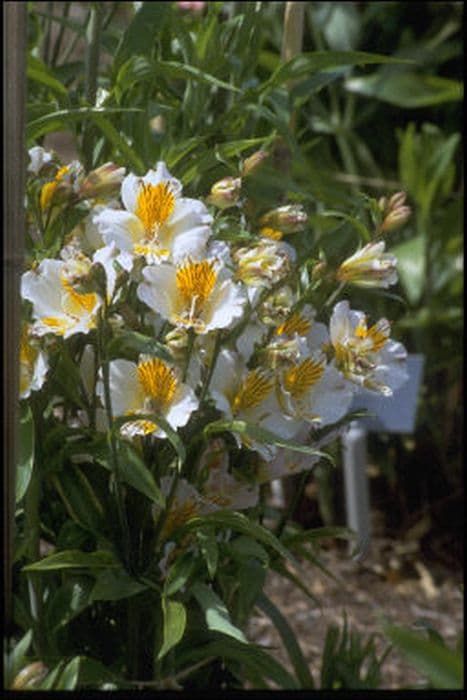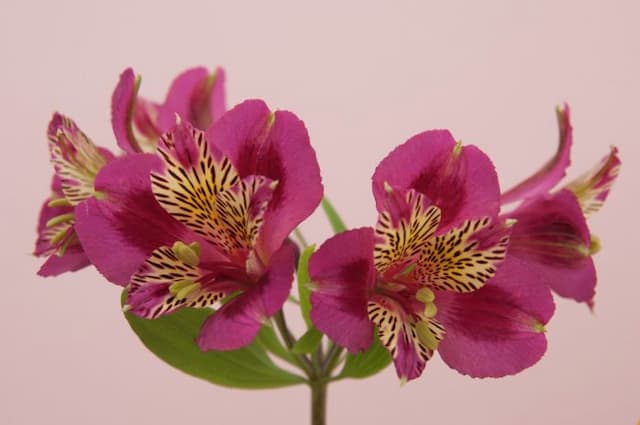Princess Lily Alstroemeria Princess Eliane = 'Zaprielia' (PBR) (Princess Series)
![Peruvian lily [Princess Eliane]](/_next/image?url=https%3A%2F%2Fplants-admin.emdemapps.com%2Fimages%2Fplants%2F%2Fimages%2F604b557288bb8.png&w=3840&q=75)
ABOUT
Alstroemeria Princess Eliane, also known as the Peruvian Lily or Lily of the Incas from the Princess Series, is notable for its striking blooms which exhibit a blend of vibrant colors. The flowers are characterized by a unique combination of pink and yellow hues, with each petal beautifully edged in a contrasting color. These petals often have speckled or streaked patterns in darker shades, adding depth and complexity to the flower's appearance. The blossoms are formed in clusters, creating a full and lush display. The foliage of the Peruvian Lily is equally attractive, comprised of narrow, lance-shaped leaves that grow in a whorled pattern along the stems. These leaves are typically a rich green color, which sets off the brilliance of the flowers and provides a fresh background for the showy display. The overall look of the plant exhibits a harmonious interplay between the elaborate flowers and the lush foliage, creating an eye-catching ornamental specimen in gardens and landscapes.
About this plant
 Names
NamesFamily
Alstroemeriaceae
Synonyms
Peruvian Lily, Lily of the Incas, Parrot Lily
Common names
Alstroemeria 'Zaprielia'
 Toxicity
ToxicityTo humans
The common name for Alstroemeria Princess Eliane = 'Zaprielia' (PBR) (Princess Series) is Peruvian Lily. Peruvian Lilies are not highly toxic to humans, but they can cause mild irritation. If ingested, the plant may cause stomach pain, nausea, vomiting, and diarrhea. Handling the plant may also result in skin irritation or dermatitis for those with sensitive skin or allergies. It is advisable to wash your hands after handling Peruvian Lilies to avoid skin irritation.
To pets
Peruvian Lily is not highly toxic to pets, but it can cause mild gastrointestinal upset if ingested. In cats and dogs, the symptoms of Peruvian Lily ingestion may include vomiting, diarrhea, and drooling. Although the reactions are usually not severe, it's best to keep these plants out of reach and monitor your pets for any signs of distress after ingestion. If you suspect your pet has ingested Peruvian Lily and is showing symptoms, contact your veterinarian.
 Characteristics
CharacteristicsLife cycle
Perennials
Foliage type
Evergreen
Color of leaves
Green
Flower color
Mixed
Height
1-2 feet (30-60 cm)
Spread
1-2 feet (30-60 cm)
Plant type
Herb
Hardiness zones
7-10
Native area
South America
Benefits
 General Benefits
General Benefits- Vibrant Color: Provides bright and attractive flowers that can enhance the visual appeal of gardens and landscapes.
- Long Bloom Season: Offers an extended flowering period, ensuring colorful displays for much of the year.
- Cut Flower Use: The blooms are excellent for cutting and creating flower arrangements, adding beauty to indoor settings.
- Drought Tolerance: Once established, the plant is quite resilient to periods of low water availability.
- Frost Resistance: Can withstand light frosts, making it suitable for a variety of climates.
- Low Maintenance: Requires minimal upkeep beyond the basic needs, making it ideal for gardeners of all skill levels.
- Attracts Pollinators: Flowers attract bees and butterflies, supporting local biodiversity and pollination.
- Compact Growth: Its growth habit is neat and compact, which makes it suitable for container gardening or small spaces.
- Versatile Placement: Can be planted in flower beds, borders, containers, and makes an attractive edge plant due to its height and form.
- Long-lasting Perennial: As a perennial, it returns year after year, providing long-term value and reducing the need for annual replanting.
 Medical Properties
Medical PropertiesThis plant is not used for medical purposes.
 Air-purifying Qualities
Air-purifying QualitiesThis plant is not specifically known for air purifying qualities.
 Other Uses
Other Uses- Photography Prop: Alstroemeria Princess Eliane can serve as an exquisite subject or backdrop for photographers, especially those specializing in botanical or nature-themed shoots.
- Educational Resource: Botanists and horticulture educators may use the plant as a live example when teaching about hybridization, plant care, or botanical characteristics.
- Craft Projects: The vibrant petals and leaves of Alstroemeria Princess Eliane can be used in pressed flower crafts, such as bookmarks, greeting cards, or wall art.
- Fashion Inspiration: Designers may draw inspiration from the colors and patterns of the Alstroemeria Princess Eliane for textile prints and fashion designs.
- Color Dye: Though not a common use, the petals could theoretically be used to create natural dyes for fabrics or art projects.
- Collector’s Item: Gardening enthusiasts who specialize in collecting various Alstroemeria cultivars might view Alstroemeria Princess Eliane as a unique addition to their collection.
- Scented Sachets: Petals and leaves, when dried, could be used to create fragrant sachets for drawers or closets.
- Gastronomy: While not typically used for consumption, its blooms could be used as a decorative, non-toxic embellishment on dishes in high-end culinary settings.
- Event Themes: The plant can inspire themes or color schemes for events like weddings, with its colors incorporated into decorations, invitations, and attire.
- Set Design: Theatre and film set designers may use Alstroemeria Princess Eliane to add natural beauty and depth to a scene, especially in productions that require lush, vibrant flora.
Interesting Facts
 Feng Shui
Feng ShuiThe Peruvian Lily is not used in Feng Shui practice.
 Zodiac Sign Compitability
Zodiac Sign CompitabilityThe Peruvian Lily is not used in astrology practice.
 Plant Symbolism
Plant Symbolism- Friendship and Devotion: Alstroemerias, commonly known as Peruvian lilies or lily of the Incas, are often associated with a strong bond between friends and a lasting commitment to mutual support.
- Wealth, Prosperity, and Fortune: The vibrant blooms of the Peruvian lily symbolize abundance and wealth, making them a common gift for wishing someone success and good fortune in their endeavors.
- Strength and Resilience: Peruvian lilies are known for their long-lasting flowers, which reflect an individual's ability to endure challenges and remain strong in the face of adversity.
 Water
WaterInca lilies should be watered regularly, aiming for consistently moist but not waterlogged soil. During the growing season, water approximately once a week with about 1-2 gallons per plant, depending on the weather and soil drainage. It is crucial to water deeply to encourage deep root growth. Inca lilies may require more frequent watering during periods of extreme heat or if they are grown in containers. During the winter, water less frequently, allowing the top inch of soil to dry out between waterings.
 Light
LightInca lilies thrive best in bright, indirect sunlight or partial shade. They should be placed in a location where they receive morning sunlight and some afternoon shade, especially in hotter climates. Avoid full, direct afternoon sunlight as it can scorch the leaves and undermine the vitality of the plant.
 Temperature
TemperatureInca lilies perform best in temperatures ranging from 60 to 75 degrees Fahrenheit. They can tolerate a minimum temperature of around 40 degrees Fahrenheit but should be protected from frost. The ideal temperature conditions for maximum growth and flowering are moderate, with little fluctuation.
 Pruning
PruningPrune Inca lilies to maintain their shape, remove spent flowers, and encourage further blooming. Pruning should be done selectively, cutting back the stems to the base after blooming to promote new growth. Perform this action throughout the growing season as flowers fade.
 Cleaning
CleaningAs needed
 Soil
SoilThe Peruvian Lily or Alstroemeria 'Princess Eliane' thrives in rich, well-drained soil with a pH between 6.5 and 7.0. A good soil mix would include equal parts garden soil, peat, and perlite or coarse sand to ensure proper drainage. Incorporating compost will enhance the soil's fertility, catering to the plant's nutritional needs.
 Repotting
RepottingThe Peruvian Lily typically does not require frequent repotting and can be left undisturbed for several years. However, when it becomes root-bound or the soil is exhausted, repotting every 2 to 3 years in fresh soil mix can promote healthier growth.
 Humidity & Misting
Humidity & MistingPeruvian Lilies prefer moderate to high humidity levels. They flourish best when humidity is maintained around 40-60%, which mimics their native tropical and subtropical environments. However, they are quite adaptable and can tolerate lower humidity levels if necessary.
 Suitable locations
Suitable locationsIndoor
Place in bright, indirect light with high humidity.
Outdoor
Plant in partial shade, sheltered from strong winds.
Hardiness zone
7-10 USDA
 Life cycle
Life cycleThe Alstroemeria Princess Eliane, commonly known as the Peruvian Lily, begins its life cycle as a dormant rhizome, which, upon planting in early spring, sprouts to form a clump of lush green foliage. The plant then enters a vegetative stage where leaves and stems develop more profusely in preparation for flowering. Around late spring to early summer, the Peruvian Lily produces clusters of trumpet-shaped flowers exhibiting vibrant colors and unique markings. After the flowering peak, each individual blossom wilts and seeds may develop, although propagation is more commonly achieved through division of rhizomes. As fall approaches, the plant’s above-ground growth dies back, and it enters a period of dormancy during the colder winter months. In the following spring, the cycle recommences as dormant rhizomes reawaken and produce new growth, continuing the perennial life cycle of the Peruvian Lily.
 Propogation
PropogationPropogation time
Spring to Summer
Alstroemeria Princess Eliane, commonly known as Peruvian Lily or Lily of the Incas, is often best propagated through division, a popular method for many Alstroemeria cultivars. The best time to divide is in the late winter or early spring just before new growth begins. To propagate by division, carefully dig up the established plant and gently separate the tuberous roots into smaller clumps, ensuring that each clump has at least one eye, or growth point. These clumps can then be immediately replanted into well-draining soil, spaced about 12 to 18 inches (30 to 46 centimeters) apart to allow room for growth. Water the newly planted divisions thoroughly to help establish them. Dividing the plants not only helps to propagate new plants but also invigorates the parent plant, encouraging more robust growth.






![Peruvian lily [Inca Coral]](/_next/image?url=https%3A%2F%2Fplants-admin.emdemapps.com%2Fimages%2Fplants%2F%2Fimages%2F604b5b79b85ce.png&w=640&q=75)
![Peruvian lily [Inca Exotica]](/_next/image?url=https%3A%2F%2Fplants-admin.emdemapps.com%2Fimages%2Fplants%2F%2Fimages%2F604b5ec0e34a9.png&w=640&q=75)
![Peruvian lily [Inca Milk]](/_next/image?url=https%3A%2F%2Fplants-admin.emdemapps.com%2Fimages%2Fplants%2F%2Fimages%2F604b5f14b0b6a.png&w=640&q=75)
![Peruvian lily [Inticancha Dark Purple]](/_next/image?url=https%3A%2F%2Fplants-admin.emdemapps.com%2Fimages%2Fplants%2F%2Fimages%2F604b5381bb78f.png&w=640&q=75)